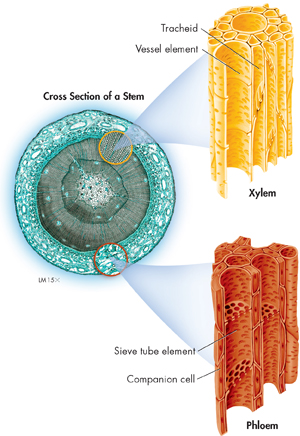Vascular Tissue The two kinds of vascular tissue are xylem, a water-conducting tissue, and phloem, a tissue that carries dissolved food. As you can see in Figure 23–2, both xylem and phloem consist of long, slender cells that connect almost like sections of pipe.  Vascular tissue supports the plant body and transports water and nutrients throughout the plant.
Vascular tissue supports the plant body and transports water and nutrients throughout the plant.
▸ Xylem: Tracheids All seed plants have xylem cells called tracheids. Recall from Chapter 22 that tracheids are long and narrow, with tough cell walls that help to support the plant. As they mature, tracheids die, leaving only their cell walls. These cell walls contain lignin, a complex molecule that resists water and gives wood much of its strength. Openings in the walls connect neighboring cells and allow water to flow from cell to cell. Thinner regions of the wall, known as pits, allow water to diffuse from tracheids into surrounding ground tissue. These adaptations allow tracheids to carry water throughout the plant and distribute it to tissues where it is needed.
▸ Xylem: Vessel Elements In addition to tracheids, angiosperms possess a second form of xylem tissue known as a vessel element. Vessel elements are wider than tracheids and are arranged end to end on top of one another like a stack of tin cans. After they mature and die, cell walls at both ends are left with slitlike openings through which water can move freely. In some vessel elements, the end walls disappear altogether, producing a continuous tube.

FIGURE 23–2 Vascular Tissue Xylem and phloem form the vascular transport system that moves water and nutrients throughout a plant. Compare and Contrast How are tracheids and sieve tube elements similar? How are they different?
▸ Phloem: Sieve Tube Elements Unlike xylem cells, phloem cells are alive at maturity. The main phloem cells are sieve tube elements, which are arranged end to end, forming sieve tubes. The end walls of sieve tube elements have many small holes through which nutrients move from cell to cell in a watery stream. As sieve tube elements mature, they lose their nuclei and most other organelles. The remaining organelles hug the inside of the cell wall and are kept alive by companion cells.
▸ Phloem: Companion Cells The cells that surround sieve tube elements are called companion cells. Companion cells keep their nuclei and other organelles through their lifetime. Companion cells support the phloem cells and aid in the movement of substances in and out of the phloem.
Table of Contents
- Formulas and Equations
- Applying Formulas and Equations
- Mean, Median, and Mode
- Estimation
- Using Measurements in Calculations
- Effects of Measurement Errors
- Accuracy
- Precision
- Comparing Accuracy and Precision
- Significant Figures
- Calculating With Significant Figures
- Scientific Notation
- Calculating With Scientific Notation
- Dimensional Analysis
- Applying Dimensional Analysis




